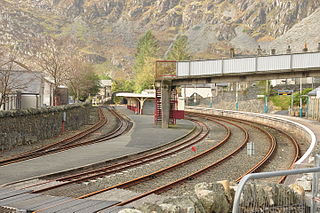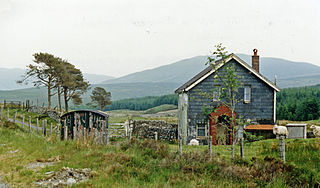History
The power station, which takes its name from the nearby village of Trawsfynydd, was designed by Basil Spence. [5] The construction, which was undertaken by a consortium involving Crompton Parkinson, International Combustion, Fairey Engineering and Richardsons Westgarth, and known as the Atomic Power Constructions (APC), [6] began in July 1959, and both of the reactors were in operation by March 1965, with the station opening fully in October 1968, at a cost of £103 million. [7] It had two Magnox reactors producing 470 megawatts (MW) in total from four turbines, each rated at 145MWe. [7] [8] The reactors were supplied by APC and the turbines by Richardsons Westgarth. [7] The civil engineering work was undertaken by Holland, Hannen & Cubitts [9] and Trollope & Colls. [10] The architectural consultant for the buildings was Sir Basil Spence and the landscape architect was Sylvia Crowe. [11] The setting for the power station which Crowe developed is designated Grade II* on the Cadw/ICOMOS Register of Parks and Gardens of Special Historic Interest in Wales. [12] Four Paxman 12YLC diesel engines, each driving a 1.2MW Crompton Parkinson alternator were installed for emergency standby duties. [13]
Nuclear flasks were transported to Trawsfynydd on a section of the former Bala to Blaenau Ffestiniog railway that had been closed in January 1961. A single track was restored northwards with an entirely new line through the centre of Blaenau Ffestiniog that connected to the Conwy Valley branch. In 1963-64, a "Goliath" gantry crane was installed over sidings about 1⁄2 mi (0.80 km) east of the power station. [14] Beginning on 20 April 1964, nuclear flasks could be transported by rail between destinations such as Sellafield in Cumbria. The last train to carry nuclear material from Trawsfynydd left on 22 April 1997 hauled by EWS Loco 37426. The line was subsequently mothballed. [18] In 2016, enthusiasts, who want to create a heritage railway, began clearing vegetation along the route but have since been halted and are negotiating a new licence to clear. [19]

Snowdonia, or Eryri, is a mountainous region and national park in North Wales. It contains all 15 mountains in Wales over 3000 feet high, including the country's highest, Snowdon, which is 1,085 metres (3,560 ft) tall. These peaks are all part of the Snowdon, Glyderau, and Carneddau ranges in the north of the region. The shorter Moelwynion and Moel Hebog ranges lie immediately to the south.

Great British Nuclear, officially British Nuclear Fuels Ltd is a nuclear energy and fuels company owned by the UK Government. It is a non-departmental public body sponsored by the Department for Energy Security and Net Zero.

Trawsfynydd is a linear village in Gwynedd, Wales, near Llyn Trawsfynydd reservoir, and adjacent to the A470 north of Bronaber and Dolgellau and 10 km south of Blaenau Ffestiniog. It also neighbours the towns of Porthmadog and Bala.

The Conwy Valley line is a railway line in north-west Wales. It runs from Llandudno via Llandudno Junction to Blaenau Ffestiniog, and was originally part of the London and North Western Railway, being opened in stages to 1879. The primary purpose of the line was to carry slate from the Ffestiniog quarries to a specially built quay at Deganwy for export by sea. The line also provided goods facilities for the market town of Llanrwst, and via the extensive facilities at Betws-y-Coed on the London to Holyhead A5 turnpike road it served many isolated communities in Snowdonia and also the developing tourist industry. Although only a little over 27 miles (43 km) between Llandudno and Blaenau Ffestiniog, the journey takes over one hour, largely due to the sinuous and steeply graded nature of the route taken. Most of the stations along the line are treated as request stops.

Wylfa nuclear power station is a Magnox nuclear power station undergoing decommissioning. Wylfa is situated west of Cemaes Bay on the island of Anglesey, off the northwestern coast of Wales. Construction of the two 490 MW nuclear reactors, known as Reactor 1 and Reactor 2, began in 1963. They became operational in 1971. Wylfa was located on the coast because seawater was used as a coolant.
The Bala and Festiniog Railway was a 4 ft 8+1⁄2 in, standard gauge, railway backed by the Great Western Railway (GWR) in north-west Wales. It connected Bala with Blaenau Ffestiniog.
Trawsfynydd Lake Halt was a solely passenger railway station near the northeastern tip of Llyn Trawsfynydd, Gwynedd, Wales. Many Nineteenth and early Twentieth Century institutions in Wales were given anglicised names, this station being one. Over the years, and especially since the Second World War, most have been rendered into Welsh or given both Welsh and English names. Trawsfynydd Lake Halt closed before this happened.

Maentwrog Road railway station was on the Great Western Railway's Bala Ffestiniog Line in Gwynedd, Wales.

Festiniog railway station served the village of Llan Ffestiniog, Gwynedd, Wales. This station was one of many 19th century institutions in Wales to be given an anglicised name. Over the years, and especially since the Second World War, most have been rendered into Welsh or given both Welsh and English names, but Festiniog station closed before this happened. The village of Llan Ffestiniog - known locally simply as "Llan" - lies over 3 km south of the larger and more recent Blaenau Ffestiniog, and over three miles south by rail.

Manod railway station served the village of Manod which then stood on the southern edge of Blaenau Ffestiniog in Gwynedd, Wales.

Magnox Ltd, currently trading as Nuclear Restoration Services, is a wholly-owned subsidiary of the Nuclear Decommissioning Authority (NDA), responsible for the safe decommissioning of British nuclear sites. Originally created for the management of Magnox nuclear reactors, it went through various forms of organisation throughout privatisation of the nuclear industry, until coming into NDA ownership in 2019. It rebranded to NRS in October 2023.
Bryn-Celynog Halt was an unstaffed solely passenger railway station which served the rural area of Bryn-Celynog, east of Trawsfynydd, Gwynedd, Wales.
Llafar Halt was an unstaffed solely passenger railway station which served the rural area of Glanllafar, east of Trawsfynydd, Gwynedd, Wales.

Teigl Halt was a solely passenger railway station which served the rural area of Cwm Teigl, south of Blaenau Ffestiniog, Wales.

Cwm Prysor Halt was a railway station which served the remote rural area of Cwm Prysor, east of Trawsfynydd, Gwynedd, Wales.
Tyddyngwyn railway station was immediately north of the later Manod station in what was then Merionethshire, now Gwynedd, Wales.
Glynllifon Street railway station was a temporary northern terminus station of the Festiniog and Blaenau Railway (F&BR), sited between the street of the same name and Cwmbowydd Road in Blaenau Ffestiniog. It was never named.

On 10 September 1883, the Bala and Festiniog Railway (B&FR) and the Festiniog Railway (FR) opened what would be known as an interchange station in Blaenau Ffestiniog, Merionethshire, Wales. Merionethshire is now part of the county of Gwynedd.

North west Wales experienced a slate boom in the first half of the nineteenth century. Three sites stood out as experiencing the most explosive growth: Dinorwic near Llanberis, Penrhyn near Bethesda and Blaenau Ffestiniog.
Diphwys railway station was on the same site as the later Great Western Railway station in the heart of Blaenau Ffestiniog in what was then Merionethshire, now Gwynedd, Wales.














